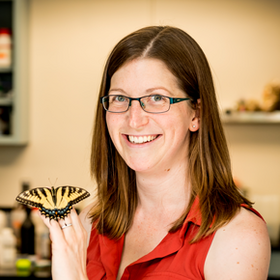

Emilie C.
Snell-Rood
The Snell-Rood lab studies why organisms vary in their response to novel environments, for instance due to learning or general stress responses. We use this understanding to inform efforts related to conservation, such as restoration of roadsides or urban greenspaces. We are also interested in bridges between biology and design and engineering, through educational efforts to bring more biology into bio-inspired design.
Research interests
Organisms today are faced with environmental change on a scale unknown in their evolutionary history. Their ancestral habitats have been converted to monocultures of crops or expanses of houses; ecosystem nutrient cycles are shifting due to fertilizer application; and the climate is changing rapidly. How will organisms respond to such novel and rapid changes in their environment? Not only is this a pressing question for conserving biodiversity, but it is also relevant for understanding how past environmental change has shaped modern biological diversity. My lab takes both a basic and applied approach to understanding responses to environmental change. We ask why some organisms cope with environmental change and others are more specialized? What are the consequences of such variation for survival in novel environments and conservation of biodiversity? We focus on several novel, anthropogenic environments -- cities, agricultural environments and roadsides. In doing so, we also address conservation-related questions. Current work considers pockets of urban habitat and threats of pollutants such as heavy metals and microplastics.
Selected publications
Shephard, AM, AK Hund, EC Snell-Rood. 2023. Metabolic stress as a driver of life-history plasticity: flight promotes longevity and antioxidant production in monarch butterflies. Proceedings of the Royal Society B 290 (2008), 20231616.
Snell-Rood, EC and ME Kobiela. 2023. Rearing the Cabbage White Butterfly (Pieris rapae) in Controlled Conditions: A Case Study with Heavy Metal Tolerance. Journal of Visual Experiments e65383
E Snell-Rood and D Smirnoff. 2023. Biology for biomimetics I: function as an interdisciplinary bridge in bio-inspired design. Bioinspiration and Biomimetics 18 (5), 052001.
Snell-Rood, EC and SM Ehlman. 2023. Developing the genotype-to-phenotype relationship in evolutionary theory: A primer of developmental features. Evolution and Development 25:393-409.
Hund, A.K., E. Stretch, D. Smirnoff, G. H. Roehrig, E. C. Snell-Rood. 2023. Broadening the taxonomic breadth of organisms in the bio-inspired design process. Biomimetics 8:48.
Shephard, A., L. Agnew, A. Herdtle, T. Mitchell, E. Borer, E. Snell-Rood. 2022. Traffic patterns, more than landscape context, influence element content of roadside forbs for insect pollinators. Ecological Solutions and Evidence 3: e12195.
Zambre, AM, L Burns, J Suresh, AD Hegeman, E Snell-Rood. 2022. Developmental plasticity in multimodal signals: light environment produces novel signaling phenotypes in a butterfly. Biology Letters 18: 20220099.
Snell-Rood, E. C. and C. N. Snell-Rood. 2020. The developmental support hypothesis: adaptive plasticity in neural development in response to cues of social support. Philosophical Transactions of the Royal Society B 375:20190491.
Snell-Rood, E. C., E.M. Swanson, A. Espeset, S. Jaumann, K. Phillips, Courtney Walker, Brandon Semke, A.S. Mori, G. Boenisch, J. Kattge, E.W. Seabloom, E.T. Borer. 2020. Nutritional constraints on brain evolution: sodium and nitrogen limit brain size. Evolution 74:2304-2319.
Education
Ph.D., University of Arizona, Tucson, 2007